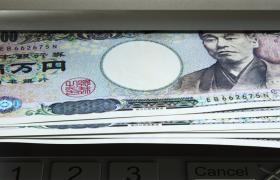2019 was a big year. Old Town road was released, another Royal Baby was born, China landed on the dark side of the moon, the Notre Dam and a massive chunk of the Amazon burned down, the first all-women spacewalk took place, the internet decided to storm Area 51, and everyone became obsessed with baby Yoda. As I said, it was a big year that was filled with good, the bad, the ugly and the inspiring.
As we reflect on the year that was, we wanted to see how the little Aussie battler, or AUD, fared in 2019. While each week brought new social, political and economic factors that influenced the Aussie dollar, a few key themes held steady and had the most significant impact on our currency.
Before we dive into those themes a little more, let’s take a look at where the AUD sat on December 1 compared to January 1, 2019. This gives an excellent idea of the general movement of the Aussie dollar relative to key global currencies. It’s important to remember, though, that 11 months worth of data happened between these two figures so there were plenty of peaks and troughs that are not shown by this final figure.
|
Currency |
Value January 1 2019 |
Value December 1 2019 |
Difference when exchanging 2000 AUD |
|
0.6864 |
0.6586 |
-55.60 USD |
|
|
0.5324 |
0.504 |
-56.80 GBP |
|
|
74.0694 |
70.9393 |
-6,260.20 JPY |
|
|
0.5922 |
0.5891 |
-6.20 EUR |
|
|
0.9053 |
0.8456 |
-119.40 CAD |
|
|
1.0144 |
1.0166 |
+4.40 NZD |
|
|
0.9073 |
0.8725 |
-69.60 SGD |
Unfortunately for travellers, the Aussie dollar has dropped in value against most major currencies throughout 2019. While there were definitely peaks higher than the final value, the overall trend is downward pressure on the value of the Aussie dollar. So, why is this the case? What is decreasing the value of our precious travel money?
Biggest themes impacting the Aussie dollar in 2019
Australian Federal election
Scott Morrison’s unexpected Liberal party win at the Federal election on May 18 put upward pressure on the value of the Aussie dollar, taking it from 0.6696 USD to 0.6778 USD overnight. This might not sound like much, but if you were exchanging 2000 AUD to USD, you would have taken home an extra USD 16.40 after the election.
The Labour party was a shoo-in for the win, and markets responded in the AUD’s favour when ScoMo took home the victory. His policies heightened business confidence at the time. If only the economy had maintained this enthusiasm… which leads us to the next point.
Slowing Australian economy
Throughout 2019, the domestic economy has witnessed a significant slowdown. If we take a look at some of the key economic indicators that feed into foreign currency, it is understandable why the Aussie dollar is down since January.
- Inflation. The goal set by the Reserve Bank of Australia (RBA) is 2-3%. Q1 19 inflation sat at 1.8%, dipped to 1.3% in Q2 and now sits at 1.7% for Q4.
- NAB business confidence. At the beginning of the year consumer confidence in the economy came in at a score of 3, it dipped significantly to -0.1 in March, rose to 7 in May and finished at 0 in November. Consumer confidence was significantly impacted by both domestic and international affairs and is a good indication of how Aussies feel about the economy and their willingness to spend money. Unemployment. The unemployment rate is important as it directly impacts wage growth and, in turn, the amount of money that people are spending and injecting into the economy. The RBA has a goal of ‘full employment’, and the current unemployment rate of 5.2% is a long way off that goal. There isn’t a definite figure as to what ‘full employment’ looks like, but at this stage, it sits somewhere around 4.5%.
As a whole, markets are underwhelmed by the performance of the Australian economy despite the RBA’s best efforts to kick start spending.
Australian and US interest rate movements
Each month, central banks around the world sit and decide on interest rate movements. The Australian dollar is generally impacted by changes in both Aussie and US interest rates, particularly if they are unexpected.
Foreign currency markets are generally pretty accurate when it comes to predicting what the RBA or US Federal Open Market Committee (Fed) will do each month. As a result, they ‘price in’ or account for the interest rate change in their foreign currency movement predictions. When their prediction doesn’t come to fruition, the currency will often change as a result. As a rule of thumb, if the US increases interest rates, there will be downward pressure on the value of the AUD as investors move their funds in favour of a higher return in the US. Likewise, if RBA unexpectedly keeps interest rates on hold or the Fed decreases US rates, it is great news for the AUD.
In January this year, Australian interest rates were at 1.5%. We are closing out the year with a record low of 0.75%. While this has been done to lessen the burden on households and boost domestic spending, it has not been good news for the value of the Australian dollar.
US/China trade war
The world’s two largest economies, China and the USA have been locked in a trade war for over 18 months. US President Trump believes China has unfair trading practices and Intellectual Property theft, while China thinks the US is trying to curb its growth as a global economy. The past 18 months have seen each country retaliate with hundreds of billions of dollars worth of tariffs.
China is one of Australia’s biggest trading partners, which means our economies are intrinsically linked. As the US slapped China with more tariffs, the flow-on effects were evident in the value of the Aussie dollar, which saw long periods of downward pressure.
When new hope emerged over the trade war, the AUD would generally see some much needed upward pressure. Likewise, if this hope was ill-founded (as it often was), or if there was a last-minute change of mind, the Aussie dollar would fall against major currencies like the USD. The trade war was so impactful on the AUD that even a tweet from Trump would spark market action and reaction in our currencies value.
Thankfully we closed out the year with a partial trade agreement between the two countries. While it certainly isn’t the end, this is a step in the right direction and one that gave the Aussie dollar some solid upward pressure - just in time for those heading overseas for the festive season.
Brexit
Ah, Brexit. What a shemozzle. This year, the UK’s journey to leaving the European Union included multiple delays, a new Prime Minister, more debates than you can count, a court case, thousands of protestors and more confusion than ever. We’ve got a page dedicated to the happenings of Brexit, so check that out if you’re keen on more info (totally understandable if you’re not, though).
While Brexit hasn’t had a direct influence on the value of the Aussie dollar, except against the pound, it has contributed to the global economic outlook (covered in the next section). In terms of the AUD to GBP exchange rate, Brexit shenanigans have hurt the British economy, and the pound has weakened as a result. While Aussie’s were able to capitalise on this at times and get more when exchanging for GBP, the other negative factors outweighed Brexit and continued to push the AUD down as a result.
After Boris Johnson’s victory in the December 12th election, markets expect Brexit will take place at the end of January. With that out of the way, we now look to the UK’s ability to make a trade deal with the EU by the close of 2020. The uncertainty about the success of this deal is already weighing on the global economy and is expected to impact currency markets as we move into 2020.
Turbulent global economy
All of the above factors, particularly Brexit and the US-China trade war, alongside other worldwide economic, political and social events have weighed on the performance of the global economy. Markets were concerned over global stability, especially after Germany went into recession and other economies were slowing.
The Aussie dollar is considered a risky investment that thrives during ‘risk-on’ market sentiment that occurs when markets are stable, and investors are optimistic. Such has not been the case for a lot of the year, so safer investments like the USD and JPY saw an increase in value as investors flocked to their security. This led to even more downward pressure on the value of the Aussie dollar that was already struggling under the weight of a slowing domestic economy. All of this combined contributed to the steady decline in the value of the Aussie dollar throughout 2019.
Markets have thankfully closed out the year with a more optimistic outlook for the global economy, which helped boost the AUD. Unfortunately, we aren’t out of the woods yet, mainly because our local economy is not picking up where it should be. As frustrating as it may be for travellers, the AUD may need to take a further hit to help get the Aussie economy back on track. Frustrating in the long run, but a more prosperous domestic economy is required to ensure the wellbeing of our population which will, in turn, allow us to increase wages and spend more on holidays - yay!
As we look to 2020 and what might affect the value of the AUD, it appears to be much of the same. The US-China trade war will continue, Brexit and the trade negotiations between the UK and EU will run their course, and the RBA will continue to monitor interest rates and implement monetary policy in the hope of kick-starting our local economy.
If you are planning on travelling overseas in 2020 (we hope you are), it is worthwhile keeping an eye on foreign currency movements so you can maximise your travel money abroad. Travel Money Oz has a few nifty tools to make this process easier for you, like Rate Alerts and Rate Move Guarantee*. Be sure to visit any of our 160+ stores across Australia and New Zealand, or head online, and grab your foreign currency from the travel money experts.
This blog is provided for information only and does not take into consideration your objectives, financial situation or needs. You should consider whether the information and suggestions contained in any blog entry are appropriate for you, having regard to your own objectives, financial situation and needs. While we take reasonable care in providing the blog, we give no warranties or representations that it is complete or accurate, or is appropriate for you. We are not liable for any loss caused, whether due to negligence or otherwise, arising from use of, or reliance on, the information and/or suggestions contained in this blog. All rates are quoted from the Travel Money Oz website, and are valid as of December 24 2019. *Terms and conditions apply to Rate Guard. See https://www.travelmoneyoz.com/rate-guard for more information.














